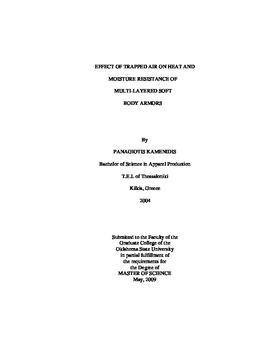| dc.contributor.advisor | Branson, Donna H. | |
| dc.contributor.author | Kamenidis, Panagiotis | |
| dc.date.accessioned | 2014-04-15T20:39:55Z | |
| dc.date.available | 2014-04-15T20:39:55Z | |
| dc.date.issued | 2009-05-01 | |
| dc.identifier.uri | https://hdl.handle.net/11244/8968 | |
| dc.description.abstract | This study investigated the potential for a proof of concept for using vacuum sealing to decrease dry (R ct ) and water vapor (R et ) resistance of multi-layered ballistic materials used in soft body armors. Phase I: Multiple layers of two ballistic materials were vacuum sealed and tested in a sweating guarded hotplate. Phase II: Test samples simulating soft body armors layering were formed using the most promising ballistic material and tested with the same apparatus and methods. Independent variables were type of enclosure material, and use or non-use of 3D spacer material and vacuum sealing.Findings and Conclusions: Phase I: Both ballistic materials presented significant differences among the different vacuum sealing applications. R ct for both Kevlar � KM2 � (KK) and Unidirectional Dyneema � (UD) can be significantly increased compared to the control by using low vacuum sealing treatments. However, with intense vacuum sealing applications only UD demonstrated significantly lower R ct values from the control. KK and UD presented a strong linear and quadratic relationship respectively, when R ct was plotted against thickness. All R et measurements were out of instrument's range. Phase I results showed that UD vacuum sealed at 2 IOM pressure was the most promising treatment for further testing in Phase II. Phase II used test samples simulated body armor layering. Mesh, no spacer and vacuum sealed UD had a significantly lower R ct compared to ripstop, with spacer and non vacuum sealed UD respectively. Based on the R ct and R et measurements, the results suggest that the most promising configuration for soft body armor includes: vacuum sealed UD with spacer placed as the layer closest to the skin and the package enclosed with mesh. Overall vacuum sealing applications of ballistic materials had merit for incorporation in the construction of soft body armors. | |
| dc.format | application/pdf | |
| dc.language | en_US | |
| dc.publisher | Oklahoma State University | |
| dc.rights | Copyright is held by the author who has granted the Oklahoma State University Library the non-exclusive right to share this material in its institutional repository. Contact Digital Library Services at lib-dls@okstate.edu or 405-744-9161 for the permission policy on the use, reproduction or distribution of this material. | |
| dc.title | Effect of Trapped Air on Heat and Moisture Resistance of Multi-Layered Soft Body Armors | |
| dc.type | text | |
| dc.contributor.committeeMember | Peksoz, Semra | |
| dc.contributor.committeeMember | Cao, Huantian | |
| osu.filename | Kamenidis_okstate_0664M_10311.pdf | |
| osu.college | Human Environmental Sciences | |
| osu.accesstype | Open Access | |
| dc.description.department | Department of Design, Housing and Merchandising | |
| dc.type.genre | Thesis | |
